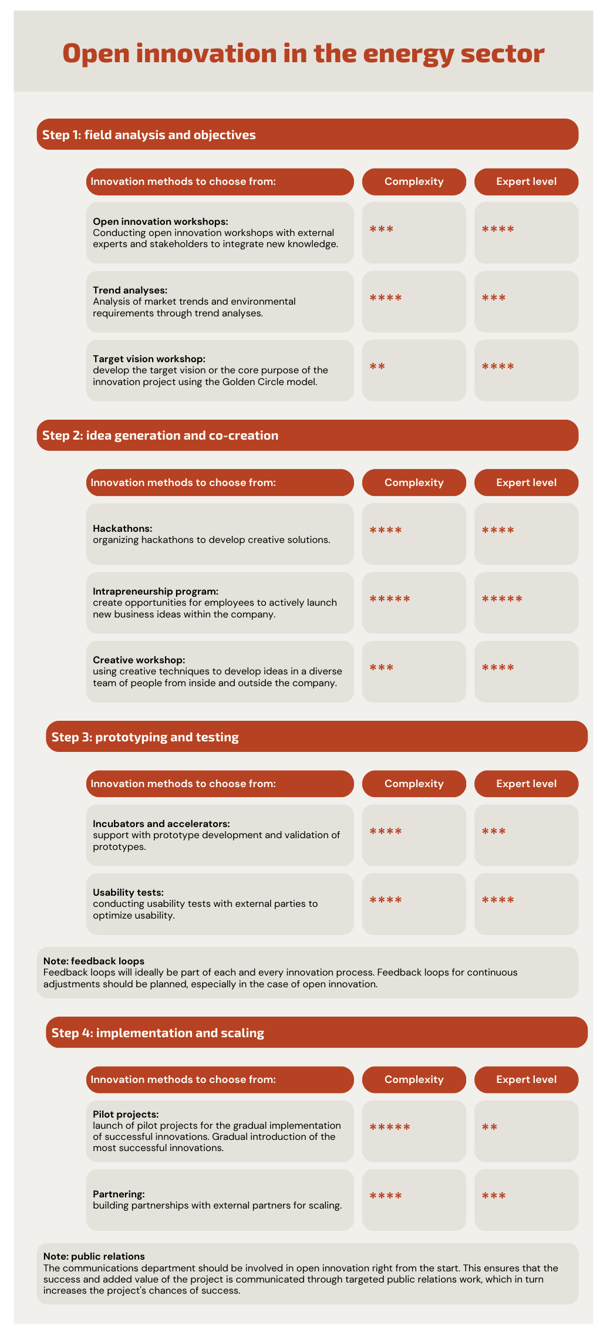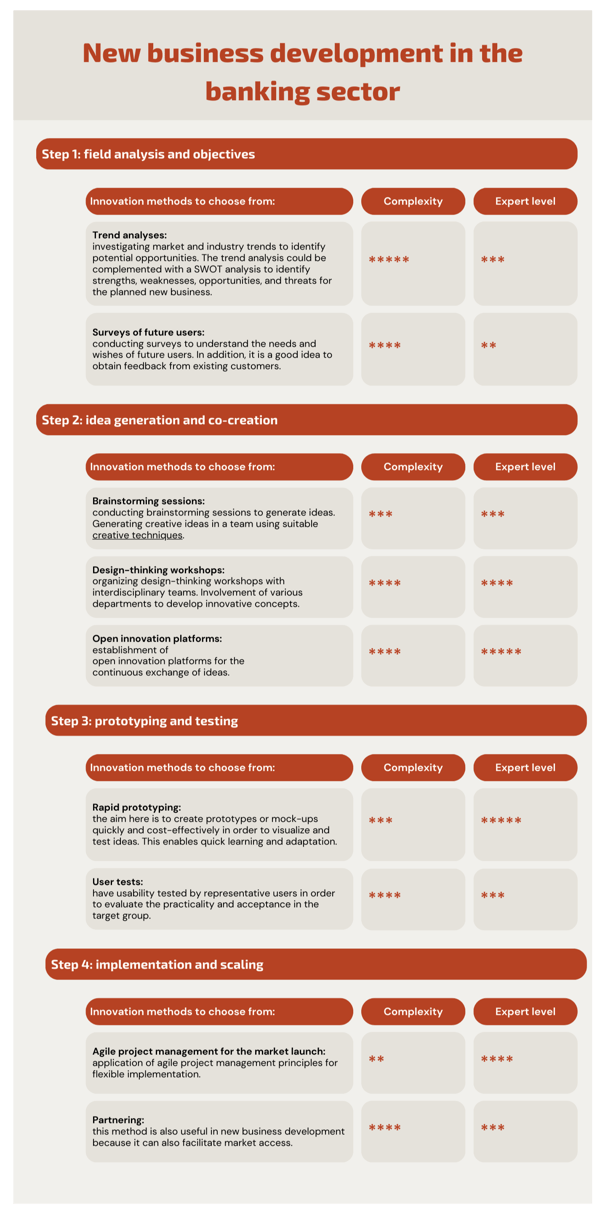Successful innovation projects with a method for more innovative strength
The 3x3 of innovation methods: 3 perspectives, 3 templates, and 3 tips

Choosing the right innovation method is not a trivial matter. This article gives an overview of common innovation methods and provides tips for more success in innovation projects.
Table of contents
Depending on the problem, a different innovation method can lead to a good solution. From the project objective to the corporate culture, all possible factors have an influence on which approach is successful. Choosing the right method is therefore extremely important in innovation projects. The specific context and factors such as the dynamics of the industry, market preferences and available resources play a decisive role here.
Definition: innovation method
A method is a systematic procedure that supports us in developing options for action, making decisions, and mastering complex tasks. Without a clear methodology, decisions are often influenced by arbitrariness and chance, which can lead to ineffective results. If you also apply a method incorrectly, the result will be an inadequate product of chance.
Within specialist circles, a popular topic of discussion is always: how do you choose the method with the best possible output?
This is the question we are addressing here. I'll start by presenting three theses, then we'll look at three examples from different industries, and finally there are some tips for innovation managers.
Three inspiring perspectives on innovation methods
Kurt Gaubinger is someone who has done a lot of work on the topic of innovation methods – especially in the context of the VUCA World. His book "Hybrid Innovation Management for SMEs in a VUCA World"
contains some good thoughts on the subject. Based on this, here are three theses on dealing with innovation methods:
- A lack of methodological competence has consequences for innovation performance.
If the wrong innovation methods are used, this weakens the outcome of the innovation process. For example, it can delay the time-to-market, as decisions take longer or process steps may have to be repeated. A clear methodology helps to identify bottlenecks and inefficient processes, leading to improved productivity and profitability. - Innovation methods are closely linked to the innovation strategy.
Methodological competence is also crucial in order to be effective in terms of strategy. A clear methodology helps to develop strategies based on sound analyses and forecasts. Without this expertise, it can be difficult to make the right decisions and keep the company on track.
Methodological competence in innovation is therefore also an issue for managers. If this competence is lacking, ineffective decisions and strategic uncertainty result. - Intuition and a systematic approach are both required for innovation.
Intuition, and the implicit knowledge that goes with it, plays an important role in management decisions. Yet in an environment as complex as innovation, not everything can be decided on instinct. So if you want to make a difference, you should build up a set of innovation methods in innovation management and not just rely on your gut feeling.
Three examples of choosing the right methods in innovation projects
The choice of method must be tailored to the specific requirements of the company. Three examples of what this can look like in practice:
Example 1: innovation strategy and open innovation in the energy sector
In this fictitious example in the energy supplier sector, a company – let's call it "EcoPower Solutions" – is faced with the challenge of asserting itself in an increasingly competitive market environment while at the same time meeting increasing environmental requirements. In order to develop an effective innovation strategy and launch appropriate initiatives, those responsible for innovation could use the following methods in the various phases:

Example 2: service design and medical technology
Suppose a medical technology company intends to introduce a service innovation to improve the user experience.
Let's call the company "MediLife Solutions". The company faces the challenge of developing a service innovation that meets the needs of medical professionals in emergency operations. To tackle this task, MediLife Solutions could proceed as follows, building on the lead user method.
-1.png?width=600&height=1334&name=EN%20Servicedesign%20und%20Medizintechnik%20%20(1)-1.png)
Example 3: new business development in the banking sector
A fictitious example, from the banking sector: an established banking company wants to push ahead with a new business development project. Let's call the innovation project "BankXperience". The challenge is to build up core competencies outside of banking.

Three tips for more implementation power through methodological competence
From my personal experience, here are three more tips in connection with methodological expertise in innovation management:
- Every innovation team must build up a portfolio of methods.
Innovation teams need to build up a portfolio of methods. This is a collection of methods and tools that help to achieve objectives in different use cases. This includes, for example, idea generation techniques, market research methods, or project management tools. With the right mix of methods, innovation teams can increase project success. - Set incentives and involve everyone.
It is important that every employee's performance targets are linked to innovation. In addition, everyone should be able to take part in idea competitions and innovation projects in order to strengthen the culture of innovation and obtain a broad spectrum of ideas. - Critically scrutinize the choice of method.
Managers should ask critical questions in their innovation teams about the appropriate innovation methods to ensure that the chosen approach is effective and goal-oriented. One of the first questions before choosing a method should be: "Is the innovation project technology-driven or market-driven?"
Conclusion
The use of innovation methods is the key to strategic and operational innovation management. For innovation projects to be successful, a method-centered approach is required. What should not be the case is that the choice of method depends on the qualifications of the project team or which method is currently in vogue.
Different projects, industries, and organizational cultures require different approaches. Choosing the right innovation method helps innovation teams and managers:
- to ensure coordination.
- to maximize efficiency.
- to encourage creativity.
- to manage risk.
- to pursue continuous improvement.
The right approach lays the foundation for successful innovation projects and increases the likelihood of achieving the desired results. Managers can take various measures (e.g. training) to ensure that innovation methods are implemented effectively.
Sources: :
Kurt Gaubinger (2021): Hybrides Innovationsmanagement für den Mittelstand in einer VUCA-Welt, Springer.









